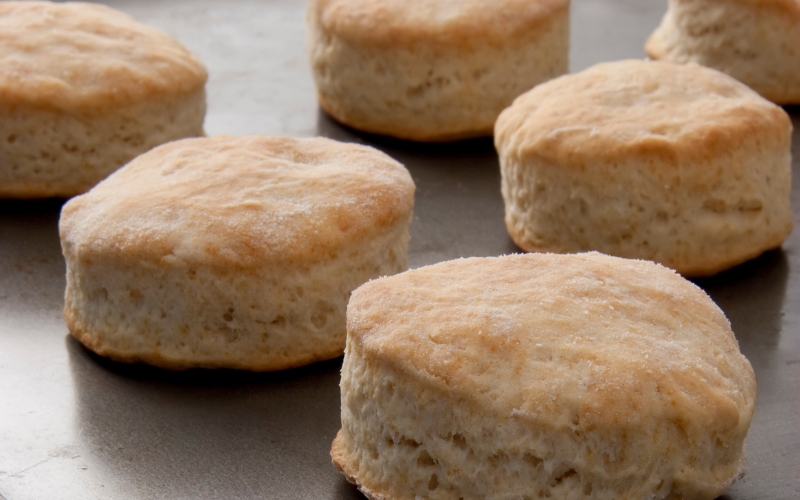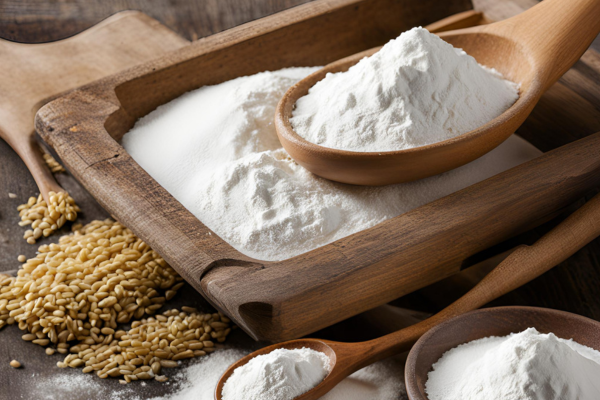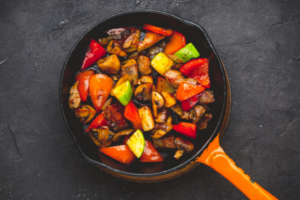the history of baking powder
Baking powder, a common household staple, is an essential leavening agent in modern recipes. Its ability to make baked goods rise, giving cakes, muffins, and biscuits their light, fluffy texture, revolutionized home cooking and commercial baking. However, the road to this invention was long and filled with experiments, innovations, and even industrial competition.
Early Leavening Agents
Before baking powder, leavening agents used in baking were far more primitive. Yeast, a natural microorganism, was the most common leavening agent for bread and other baked goods. However, it was time-consuming and unpredictable, requiring hours for dough to rise. For lighter, quicker breads, bakers often relied on “chemical leavening” by using substances like potash (a form of potassium carbonate). Potash, derived from wood ash, was often mixed with acidic ingredients such as sour milk or cream of tartar to produce carbon dioxide, which would create air pockets in the dough. But these methods were inconsistent, resulting in unreliable baking results.
The Birth of Baking Soda
The first major step toward modern chemical leavening came with the discovery of sodium bicarbonate, commonly known as baking soda. In the 18th century, chemists discovered that this white, crystalline compound, when combined with an acid, produced carbon dioxide, which helped dough rise. Baking soda was much more predictable and effective than its predecessors, but it still required an acidic ingredient, such as buttermilk, vinegar, or lemon juice, to activate the chemical reaction. The limitation of needing an acid often complicated recipes and made it less convenient for everyday bakers.
The Invention of Baking Powder
The invention of baking powder was a game-changer because it simplified the processes. The credit for developing baking powder as we know it today is often attributed to Alfred Bird, a British chemist, who invented the first commercial baking powder in 1843. Bird’s baking powder was made from sodium bicarbonate and cream of tartar, a byproduct of winemaking. His innovation came from a personal need—his wife was allergic to yeast, so Bird sought a yeast-free way to leaven dough.
While Bird’s invention laid the groundwork, baking powder didn’t gain widespread popularity until an American chemist, Eben Horsford, took it a step further in the 1850s. Horsford, a Harvard professor with a passion for chemistry and nutrition, developed the first truly modern baking powder. Instead of cream of tartar, he used calcium acid phosphate, an acid more readily available and easier to manufacture than cream of tartar. Horsford’s baking powder could be used with any liquid, removing the need for acidic ingredients in recipes.
Horsford patented his invention and founded the Rumford Chemical Works, which became one of the largest producers of baking powder. His baking powder was both affordable and consistent, making it popular among households and bakeries alike.
The Rise of Double-Acting Baking Powder
While Horsford’s invention simplified baking, there was still room for improvement. His single-acting baking powder reacted immediately when mixed with liquid, meaning bakers had to work quickly to avoid losing the leavening effect before baking. In 1889, a significant leap occurred with the development of double-acting baking powder, which includes both fast-acting and slow-acting acids.
Double-acting baking powder contains two types of acids: one that reacts with liquid and another that reacts with heat. This innovation meant that a portion of the carbon dioxide is released as soon as the batter is mixed, and the remainder is released during baking, ensuring a more reliable rise. Bakers no longer needed to rush through their recipes, and this made the product even more versatile.
The Baking Powder Wars
The mass production of baking powder led to fierce competition between manufacturers in the late 19th and early 20th centuries, an era known as the “Baking Powder Wars.” Companies such as the Royal Baking Powder Company and the Rumford Chemical Works engaged in marketing battles to promote their products. The competition was so intense that it even led to litigation over patents and advertisements. Some companies falsely claimed their products were superior, resulting in consumer confusion. Eventually, the FDA began regulating production to ensure consistent quality and labeling, bringing stability to the market.
Baking Powder's Impact on Modern Baking
The widespread availability of baking powder transformed how people baked at home and in commercial kitchens. Recipes became more accessible to home cooks who no longer had to rely on yeast or tricky chemical reactions to achieve a good rise in their baked goods. Cakes, quick breads, biscuits, and cookies all became easier and faster to prepare, leading to the rise of many modern baked goods we enjoy today.
Today, baking powder is available in nearly every supermarket, an indispensable tool for professional bakers and casual home cooks alike. Its simplicity and reliability ensure its continued use in kitchens around the world.
A Simple, Classic Recipe: Fluffy Baking Powder Biscuits
To fully appreciate the magic of the ingredient, why not try a classic recipe that showcases its power? Fluffy, golden biscuits are a perfect example of how baking powder transforms simple ingredients into a tender, delicious treat. Here’s an easy recipe you can try at home:
Ingredients
- 2 cups all-purpose flour
- 1 tablespoon baking powder
- ½ teaspoon salt
- ½ cup cold unsalted butter, cut into cubes
- ¾ cup milk (whole milk is preferred for extra tenderness)


Instructions
- Preheat your oven to 425°F (220°C). Line a baking sheet with parchment paper or lightly grease it.
Combine the dry ingredients: In a large mixing bowl, whisk together the flour, baking powder, and salt.
Cut in the butter: Using a pastry cutter or your fingertips, work the cold butter into the dry ingredients until the mixture resembles coarse crumbs. Small pea-sized pieces of butter should remain; they will help create those flaky layers in your biscuits.
Add the milk: Slowly pour the milk into the mixture, stirring gently with a fork until the dough just comes together. Be careful not to overwork the dough to ensure your biscuits stay tender and light.
Form the biscuits: Turn the dough out onto a lightly floured surface. Gently knead it a couple of times to bring it together, then pat the dough into a ½-inch-thick rectangle. Use a round biscuit cutter or the rim of a glass to cut out your biscuits. Gather any scraps, reshape, and cut again until all the dough is used.
Bake: Place the biscuits on the prepared baking sheet, making sure they are slightly touching for soft-sided biscuits, or spaced apart for crisp edges. Bake for 12-15 minutes, or until the tops are golden brown.
Enjoy: Serve warm with butter, jam, or your favorite spread. These biscuits also make excellent bases for breakfast sandwiches or a side for hearty soups and stews.
Legacy in the Kitchen
This simple recipe illustrates the profound impact baking powder has had on the culinary world. From the rise of quick breads to the invention of modern-day cakes and pastries, the ingredient has revolutionized the art of baking by making it faster, more accessible, and far more predictable. In fact, biscuits like the ones you can make with the recipe above are a perfect testament to how far baking has come from the unpredictable days of yeast and chemical guesswork.
Today, the easy availability of baking powder in every supermarket shelf ensures that no matter your skill level, creating fluffy, delicious baked goods is within your reach.



